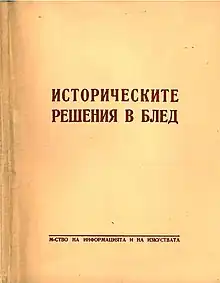Bled agreement (1947)
The Bled agreement (also referred to as the "Tito–Dimitrov treaty") was signed on 1 August 1947 by Georgi Dimitrov and Josip Broz Tito in Bled, PR Slovenia, FPR Yugoslavia and paved the way for a future unification of Bulgaria and Yugoslavia in a new Balkan Federation. It also foresaw the unification of Vardar Macedonia and Pirin Macedonia and the return of Western Outlands to Bulgaria. The agreement abolished visas and allowed for a customs union. It was also the first time that Bulgaria recognized ethnic Macedonians and the Macedonian language.

These agreements marked the mutual aspirations and efforts to develop new relations between the two countries. They agreed that the government will take over NR Bulgaria to ensure the rights of ethnic Macedonians in Pirin Macedonia (now Blagoevgrad Province) in free national economic and cultural development.
The Bled agreement was accepted with the "Treaty on Friendship, Cooperation and Mutual Assistance" between Yugoslavia and Bulgaria, signed and published in Evksinograd. The treaty contains several agreements on: economic cooperation, customs facilitation, preparation of a customs union, facilitation of border crossings, border crossing on the border of population and of the citizenship between the two countries. The Yugoslav Government waived $25 million in war damages owed by Bulgaria towards Yugoslavia.
The policies resulting from the agreement were reversed after the Tito–Stalin split in June 1948, when Bulgaria, not wanting to be a seventh republic of Yugoslavia as Tito imagined and being tied to the interests of the Soviet Union, took a stance against Yugoslavia.[2] When the Cominform campaign against Yugoslavia severed the Yugoslav Communist Party leadership, the government of Bulgaria on 1 October 1949 deleted the Treaty on Friendship, Cooperation and Mutual Assistance of Bled with all its agreements. A CIA document from November 1948, declassified in 2011, outlines the tensions between the two countries and the outlook of the people of Yugoslav Macedonia.[3]
See also
Notes
- http://macedonia.kroraina.com/pamphlets/bled_1947.htm
- Stavrianos (1964)
- CIA Information report, November 1948 "YUGOSLAV-BULGARIAN TENSION IN THE YUGOSLAV-MACEDONIA REGION"
References
- Stavrianos, L. (1964) Balkan Federation: A History of the Movement Toward Balkan Unity in Modern Times. (Hamden, CT: Archon Books).


.svg.png.webp)